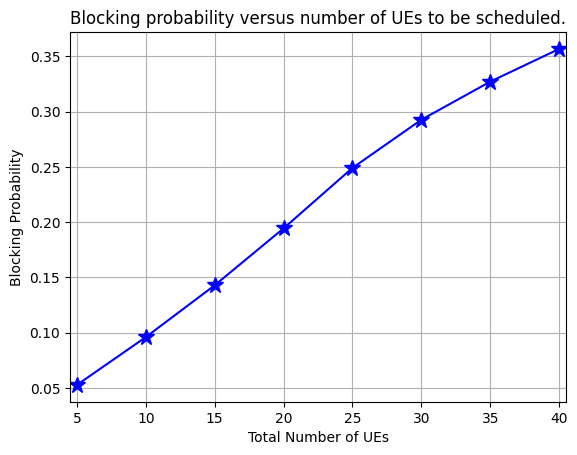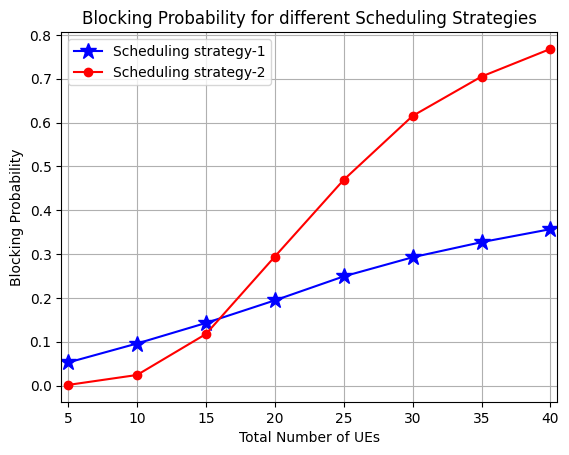Analyzing the Impact of Scheduling Strategy on Blocking Probability
In this notebook, we simulate the impact of scheduling strategy on
blocking probabilityBase Station (BS) scheduler allocates different set of CCEs to different UEs based on a certain
strategyFor instance, let us consider two scheduling strategies namely
strategy 1andstrategy 2, wherestrategy 1: scheduler allocates UEs from low-to-high ALs. i.e., UEs with lower AL are scheduled first.strategy 2: scheduler allocates UEs from high-to-low ALs. i.e., UEs with higher AL are scheduled first.
Python Libraries
[1]:
import os
os.environ["CUDA_VISIBLE_DEVICES"] = "-1"
os.environ['TF_CPP_MIN_LOG_LEVEL'] = '3'
# %matplotlib widget
import matplotlib.pyplot as plt
import matplotlib.patches as mpatches
import matplotlib as mpl
import numpy as np
5G-Toolkit Libraries
[2]:
import sys
sys.path.append("../../")
from toolkit5G.Scheduler import PDCCHScheduler
Simulation Parameters
The following parameters are used for this simulation: - coresetID denotes the coreset ID. - slotNumber denotes the slot-number carrying the PDCCH. - searchSpaceType denotes the search space type. UE specific search space (USS) or Common search space (CSS). - nci denotes the variable corresponding to carrier aggregation. Current simulation does not assume carrier aggregation.
[3]:
mu = np.random.randint(4) # numerlogy for sub-carrier spacing
coresetID = 1 # coreset ID
slotNumber = 0
searchSpaceType = "USS" # search space type. UE specific search space
nci = 0 # variable corresponding to carrier aggregation
numIterations = 1000
PDCCH Scheduling Parameters
Following parameters are crucial for PDCCH scheduling performance: - Nccep denotes coreset size or number of CCEs available for scheduling UEs. - strategy denotes the scheduling strategy. - numCandidatesUnderEachAL denotes number of PDCCH candidates per aggregation level. - aggLevelProbDistribution denotes the probability distribution with which the scheduler chooses a particular aggregation level (AL) for each UE. Supported ALs under USS are 1,2,4,8,16.
[4]:
Nccep = 54
maxNumUEs = 40
numUEs = np.arange(5,maxNumUEs+1,5)
aggLevelProbDistribution = np.array([0.4, 0.3, 0.2, 0.05, 0.05])
numCandidates = np.array([6,6,4,2,1], dtype=int)
pdcchSchedulerObj = PDCCHScheduler(mu, slotNumber, coresetID, nci)
Simulation for Scheduling Strategy-I
[5]:
##############
# Strategy 1
##############
strategy = "Conservative"
probOfBlockingForStrategy1 = np.zeros((numUEs.shape))
for n in range(numUEs.size):
print("Simulating (n,numUEs) : "+str(n)+", "+str(numUEs[n]))
prob = 0
for i in range(numIterations):
ueALdistribution = np.random.multinomial(numUEs[n], aggLevelProbDistribution)
rnti = np.random.choice( np.arange(1,65519+1), size = (numUEs[n],), replace=False)
count = pdcchSchedulerObj(Nccep,searchSpaceType,ueALdistribution,numCandidates,rnti,strategy)[0]
numBlockedUEs = np.sum(count)
prob = prob + numBlockedUEs/numUEs[n]
probOfBlockingForStrategy1[n] = prob/numIterations
Simulating (n,numUEs) : 0, 5
Simulating (n,numUEs) : 1, 10
Simulating (n,numUEs) : 2, 15
Simulating (n,numUEs) : 3, 20
Simulating (n,numUEs) : 4, 25
Simulating (n,numUEs) : 5, 30
Simulating (n,numUEs) : 6, 35
Simulating (n,numUEs) : 7, 40
Blocking probability vs number of UEs to be scheduled.
Its the recreation of
Fig. 4: Blocking probability versus number of UEs to be scheduled.from the reference paper referenced below [1].Figure shows that by doubling the number of UEs from 15 to 30, the blocking probability increases from 0.15 to 0.3, corresponding to an increase by a factor of 2.
[6]:
fig, ax = plt.subplots()
ax.plot(numUEs, probOfBlockingForStrategy1, marker = "*",linestyle = "solid", ms = 12, c = 'b')
ax.set_xlabel('Total Number of UEs')
ax.set_ylabel('Blocking Probability')
ax.set_title('Blocking probability versus number of UEs to be scheduled.', fontsize=12)
ax.set_xticks(numUEs)
ax.set_xlim([numUEs[0]-0.5, numUEs[-1]+0.5])
ax.grid()
plt.show()

Simulation for Scheduling Strategy-II
[7]:
##############
# Strategy 2
##############
strategy = "Aggressive"
probOfBlockingForStrategy2 = np.zeros((numUEs.shape))
for n in range(numUEs.size):
print("Simulating (n,numUEs) : "+str(n)+", "+str(numUEs[n]))
prob = 0
for i in range(numIterations):
ueALdistribution = np.random.multinomial(numUEs[n], aggLevelProbDistribution)
rnti = np.random.choice( np.arange(1,65519+1), size = (numUEs[n],), replace=False)
count = pdcchSchedulerObj(Nccep,searchSpaceType,ueALdistribution,numCandidates,rnti,strategy)[0]
numBlockedUEs = np.sum(count)
prob = prob + numBlockedUEs/numUEs[n]
probOfBlockingForStrategy2[n] = prob/numIterations
Simulating (n,numUEs) : 0, 5
Simulating (n,numUEs) : 1, 10
Simulating (n,numUEs) : 2, 15
Simulating (n,numUEs) : 3, 20
Simulating (n,numUEs) : 4, 25
Simulating (n,numUEs) : 5, 30
Simulating (n,numUEs) : 6, 35
Simulating (n,numUEs) : 7, 40
Plotting Blocking Probability vs Number of UEs for Scheduling Strategy
Its the recreation of
Fig. 10: Blocking probability for different scheduling strategiesfrom the paper referenced below [1].Figure shows that
strategy 1 outperforms strategy 2 in terms of blocking probability.The reason is that strategy 2 prioritizes UEs with high ALs that uses more number of CCEs, thus resulting in a higher blocking probability compared to strategy 1.
For instance, in strategy 2, a UE using AL 16 may block 16 UEs using AL 1.
Also from the figure, we see that for a small number of UEs (e.g., 15) the two scheduling strategies have the same performance. However, when number of UEs increases to 40, blocking probability under strategy 2 is aproximately 3.5 times larger than the case with strategy 1, in the CORESET size of 54 CCEs.
Note that the performance of different scheduling strategies is also
dependent on the CORESET size.
[8]:
fig, ax = plt.subplots()
ax.plot(numUEs, probOfBlockingForStrategy1, marker = "*",linestyle = "solid", ms = 12, c = 'b', label = "Scheduling strategy-1")
ax.plot(numUEs, probOfBlockingForStrategy2, marker = "o",linestyle = "solid", ms = 6, c = 'r', label = "Scheduling strategy-2")
ax.legend()
ax.set_xlabel('Total Number of UEs')
ax.set_ylabel('Blocking Probability')
ax.set_title('Blocking Probability for different Scheduling Strategies', fontsize=12)
ax.set_xticks(numUEs)
ax.set_xlim([numUEs[0]-0.5, numUEs[-1]+0.5])
ax.grid()
plt.show()

References
[1] Blocking Probability Analysis for 5G New Radio (NR) Physical Downlink Control Channel. Mohammad Mozaffari, Y.-P. Eric Wang, and Kittipong Kittichokechai
[ ]: